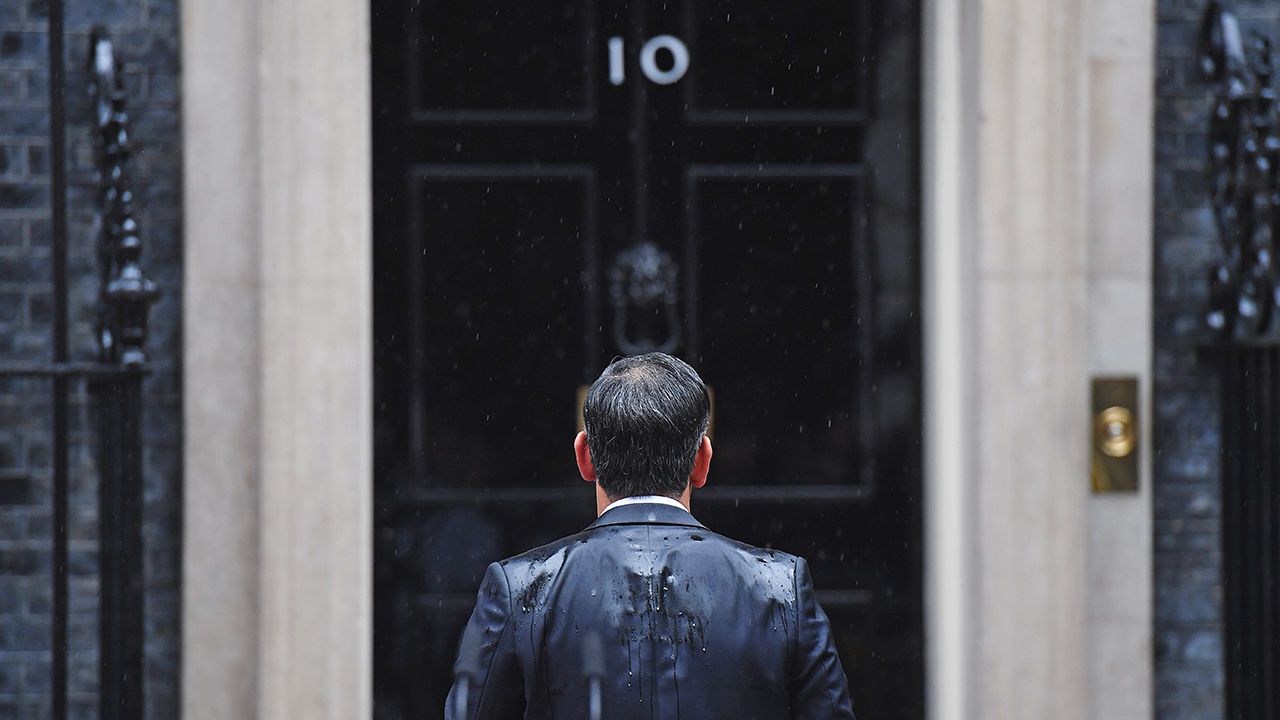
This article is more than
2 year old
By calling an election Rishi Sunak has opened the door to Number 10
Britain will hold a general election on July 4th. Announcing the news in Downing Street on May 22nd, his expression plaintive and his jacket soaked with rain, Rishi Sunak had the air of a man who knew what the result would be. Since he took office in October 2022, the prime minister has tried anything and everything to reverse the Conservative Party’s ailing poll numbers—diligent promises to reduce inflation and health-care waiting lists; bellicose swagger about deporting migrants; an offer of stability, then change, then stability again. To no avail.
The Labour Party now has an average poll lead of 23 percentage points, a deficit that no governing party has successfully overcome in an election campaign. The central scenario of The Economist’s prediction model, which draws from polls and the results in individual constituencies in elections dating back to 1959, is that Labour will win 381 seats to the Tories’ 192 (see chart), a thumping majority of 112 mps. The model gives less than a 1% chance that the Conservatives would win a majority of seats if an election were held tomorrow. A separate analysis by The Economist, based on 100,000 responses to surveys conducted by WeThink, a polling firm, shows that 96% of votershave become less likely to support the Tories than they were at the election in 2019. Polling by Ipsos finds that voters think it is “time for a change” by a margin of 73% to 18%.

Yet in the Labour Party the mood is less hubris, more terror of letting victory slip through its fingers. At a gathering of Labour thinkers on May 11th David Lammy, the shadow foreign secretary, rattled off a list of recent elections where parties that had enjoyed strong poll leads ended up suffering defeat: Hillary Clinton in America in 2016, the Australian Labor Party in 2019 and the Christian Democrats in Germany in 2021. “The election this year is still one that we can lose,” he said. Many Labour candidates report much greater cynicism on the doorstep than polls suggest. What, if anything, could derail Labour’s chances of finally winning power again?
First, the economy. Mr Sunak called the election after declaring victory in the battle against inflation, a fight that has dominated his time in office; official data show that inflation hit 2.3% in April. That followed news of strong gdpgrowth in the first quarter of the year, at 0.6%. For many Britons it “might still be hard”, acknowledged Mr Sunak, but his hope is that voters will believe that things are on the up.
The share of Britons who think the economy will be better in 12 months’ time is at its highest level since September 2021, at net -21%, although this is still pessimistic by long-term standards. Although Labour enjoys a rare lead over the Tories among voters as the best party on the economy, at 8%, this advantage is much narrower than its overall polling lead.
Next, closer scrutiny of Labour’s programme. Despite its hefty poll lead, newspapers and broadcasters still often treat the party as a curiosity. The campaign will bring greater focus on a policy agenda laced with contradictions and fragile assumptions—that it can transform public services without spending more money, or that it can meaningfully tighten labour lawswithout businesses feeling a pinch. The leadership will get more attention, too: Sir Keir Starmer, the Labour leader, is more popular than Mr Sunak but much less than Sir Tony Blair was at this point in the 1997 race. Voters are still unfamiliar with many of Labour’s front-bench team. It is not too late to make a bad first impression.
Then there is the possibility of a manifesto surprise. Here the contest is asymmetric. Labour, with everything to lose, will produce a fiscally rigid manifesto. The perils of risk-taking were made clear in 2017, when Theresa May’s plan to fund social care for the elderly through housing wealth contributed to her unexpectedly poor showing. The Tories, in contrast, will be able to go for broke. In 2007 George Osborne, then the shadow chancellor, upended Gordon Brown’s premiership with a surprise promise to cut inheritance tax; Mr Sunak will be tempted to repeat the trick, if only to shore up the Tory vote in wealthier seats vulnerable to the Liberal Democrats.
A further unknown is the impact of smaller parties. The goal of Reform uk, a right-wing insurgent party that emerged from the former Brexit Party, seems less to be winning seats than inflicting enough damage on the Conservative Party to shift it in a more radical direction in future. An average of polls puts Reform uk on 11%, with its support drawn far more from those who voted Tory in 2019 than from Labour’s ranks. But Labour is still worried that this split could reverse. “If the government is deemed to get a grip on immigration over the summer, support peeling away to Reform could be curbed,” Ellie Reeves, the party’s deputy campaign co-ordinator, told activists before the election was called.
On the left, too, Labour’s electoral coalition is more volatile than it might first appear. In local elections earlier this month, smaller parties secured 23% of the vote, with the Green Party making significant inroads in Bristol and Hastings. It is highly likely that many of these voters will switch to Labour at the general election, but not guaranteed. Some in the party are privately alarmed at the intensity of hostility towards Sir Keir in some Muslim communities over the war in Gaza, which they fear will deny the party a handful of seats.
There is also the potential impact of online activity. Much of the anger over Gaza is on TikTok. A faked audio clip circulated recently that purported to show Sir Keir abusing his staff. Mr Lammy has said that “dark forces from hostile states like Russia and Iran may seek to interfere.”
None of these factors is likely to change Mr Sunak’s prospects materially, however. Even if Labour’s poll lead narrows to 15 points, our model still gives the Tories only a one-in-ten chance of victory (rather than 1-in-100). But the spectre of throwing it all away means that Labour’s election campaign will be marked by deep caution.
For more expert analysis of the biggest stories in Britain, sign up to Blighty, our weekly subscriber-only newsletter.